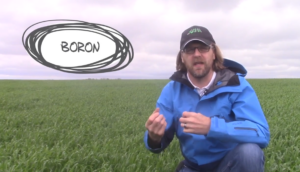SoyGreen®
Timing:
Foliar, SoilNutrient Type:
Micronutrient
Formulation:
Granular, Liquid
Why a Soil Micronutrient?
The word Micro can leave an impression that these nutrients are not as important to maximize crop production. However, even though the amount required by the crop is small relative to a macronutrient (Nitrogen, Phosphorus and Potassium) the implications of limiting one or more of these essential nutrients can have a dramatic impact on the yield of the crop.
Over the previous number of decades stewardship to micronutrient management has not been a top priority giving rise that our soils being depleted with nutrient removal exceeding application rates. However, over the last decade there has been a significant increase in micronutrient management as we need to drive the genetic yield potential of the crop.
One of the challenges is most of the micronutrients (Zinc, Manganese, Copper and Iron) (with the exception being Boron) have limited mobility in the soil meaning deficiencies can show up immediately in the young seedlings.
To ensure the plant does not ever become micronutrient deficiency it is critical to do a soil application using the proper form and placement to optimize nutrient uptake and efficiency by the plant.
The 8 key micronutrients include Zinc, Boron, Manganese, Copper, Iron, Chloride, Molybdenum, and Nickel.
There are a number of benefits of using a soil micronutrient that include (but not limited to);
- Optimize multiple enzymatic processes to maximize photosynthesis.
- Maximize rooting by the crop.
- Ensure proper cell wall and membrane formation in both the roots and leaves of the plant.
- Compliment Nitrogen, Phosphorus, Potassium and Sulphur nutrition to keep all essential nutrients in balance.
- Important for abiotic stress tolerance
- Maintain optimum plant health to help the young plants ward off invasion by pathogen and insects (biotic stress).
- In most situations, the micronutrient can be blended with a soil macronutrient program.
To confirm if a micronutrient application is required, it is recommended to do a complete soil analysis for each field. Be sure to include the crop being grown when performing the soil sample as each crop is unique in their micronutrient requirements.
Related Articles

Set your Yield with Late Season Nutrition
The most stressful time in a plant’s lifecycle is at the start of flowering, due to the increasing nutrient demand of that plant. Don’t miss

How to Drive Pollination with Nutrition
To boost yield at the flowering stage of the crop, we need to maximize pollination. Two of the most important nutrients for pollination are Boron

Barry Little Retires from ATP
It is with a mix of emotions that we share the news of Barry Little’s retirement as a Regional Account Manager for the Northern Alberta
Why SoyGreen?
The patented ortho-ortho Fe EDDHA makes Soygreen® the only proven iron source for overcoming Iron Deficiency Chlorosis (IDC) in all crops, including soybeans.
- Chelated with the Levesol™ Technology, the patented ortho-ortho EDDHA keeps iron soluble and plant available as a Ferrous (Fe+2) iron.
- Improved iron uptake by the roots allows the plant to overcome iron deficiency chlorosis (IDC).
- The Levesol™ technology chelates additional micronutrients in the soil also making them available to the plant.
- Can be applied either as an in-furrow application or as an early season foliar spray.
- SoyGreen is offered in both a liquid or granular formulation to meet the needs of the growers equipment and agronomic practices.
Proven Agronomic Performance

- Data collected from 16 IDC responsive sites from across S. MB., showed that SoyGreen liquid applied at 2 lb Fe/ac (2.5 L/ac) enhanced productivity on average 4.8 bu/ac.
- In 2017 trials, SoyGreen granules on average performed equal to SoyGreen liquid on IDC responsive sites. From the 3 trial sites, the average yield benefit from SoyGreen was 4.9 bu/ac when applied at 4 lb of product/ac (2 lb Fe/ac)
- Foliar SoyGreen treatments (5 trials) from 2016 and 2017, reported an average yield enhancement of 5.1 bu/ac when compared to untreated soybeans showing IDC symptoms.
- To review the complete SoyGreen data package, please contact your ATP Technical expert today.
See the Difference
Technical Info
| PRODUCT | ANALYSIS | RATE | TIMING | FORM | PRODUCT SIZE |
|---|---|---|---|---|---|
| 1.8% Fe | 2.5*-3.75** L/ac | Soil | Liquid | Case (2x9.46L), 946L |
| 3.0% Fe | 4.0*-6.0** lb/ac | Soil | Granular | 600 Lbs |
| 1.8% Fe | 1.75*** L/ac | Foliar | Liquid | Case (2x9.46L), 946L |
| 1.8% Fe | 1.25 L/ac | Soil | Liquid | Case (2x9.46L), 946L |
| 1.8% Fe | 1.25*** L/ac | Foliar | Liquid | Case (2x9.46L), 946L |
* Common rate for northern geographies
** Rate recommended for severe iron deficiency
*** Repeat when chlorosis begins to reappear. Repeat applications have shown better efficacy than a single higher rate application
**** bulk density is 43lb/ft3
Product Recommendations
- SoyGreen granules can be applied either alone or blended with other granular fertilizers. For best results, an in-furrow or side band is recommended over a broadcast application.
- SoyGreen liquid can be applied in-furrow or foliar, but research shows that in-furrow applications are the most effective.
- Post-emergent SoyGreen liquid applications should be made either before or as soon as IDC symptoms appear.
- If mixing with glyphosate, be sure to use a high quality acidifying water conditioner such as ModipHy.
- Always conduct a jar test if adding products to the SoyGreen tank mix.
- To view the SoyGreen SDS and Product Labels please visit www.atpag.com.





